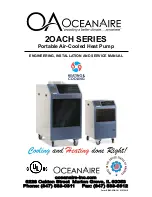
36
Testing Operation of Defrost Controller:
1. Disconnect power to heater and place a jumper across the electrical connections of the DTS.
2. With HEAT mode selected, restore power to heater and turn selected thermostat to highest setting
(heater should restart following five (5) minute time delay).
3. Using a suitable screwdriver or additional test jumpers, short across the two “test” pins located on the
defrost control board. Shorting between the test pin terminals speeds up the “ice forming” run time by a
factor of 256. In other words, if the defrost controller has been time-set for a 50-minute “ice forming”
run time– with the test pins remaining shorted, the heater should go into defrost in approximately 20-
seconds.
4. If defrost does not initiate using this test method, the defrost controller is suspect. However, before
condemning the controller, with test underway, measure voltage across CR-1 control coil; if 24-volts
can be measured there, the inability to initiate defrost likely lies with CR-1, the RRV, or associated
wiring. Troubleshoot those components as you would any other electromechanical device.
Testing Operation of Defrost Temperature Sensor :
Failure to heed the following may result in permanent injury or
death.
WARNING !
Heat pumps contain no owner-repairable components. Repairs must not be attempted by untrained
and/or unqualified individuals. If service is deemed necessary, contact installing dealer or AquaCal
Customer Support at: (800) 786-7751. The following defrost system troubleshooting procedures to
be performed by authorized service personnel only.
Troubleshooting Defrost System
The Following Procedure to be Performed by Qualified HVAC Service Personnel Only
(Best Performed After Verifying Remaining Portions of Defrost System Are Functional)
1. Disconnect power to heater; remove black fan motor power wire from the fan relay terminal.
Electrically isolate the removed wire and female connector using a wrap of electrical tape.
2. Attach refrigerant service manifold gages to refrigerant test ports. Attach a reliable, surface-reading
thermometer to the suction line (clamp-on thermocouple-type recommended). Position the
thermometer probe as close as possible to the evaporator outlet..
3. Repeat analysis procedure per Testing Operation of Defrost Controller, except do NOT “...place a
jumper across the DTS terminals.”
4. Start heater. After a period of a few minutes, because the fan is not operating, evaporator temperature
should fall to a point where the DTS closes and defrost initiates.
5. To prevent compressor damage as test progresses, monitor the suction tube temperature and
superheat developed; terminate test if superheat approaches “0”. The suction tube temperature should
also be used as a relative guide as to the temperature seen by the DTS.
6. If DTS does not close and initiate a defrost cycle, repeat test substituting a known-to-be-seviceable
DTS.
7. In some instances, moving the DTS to a new coil position–closer to where ice is forming–will solve
defrost initiation issues.
8. Restore fan circuit wiring to normal configuration.









































